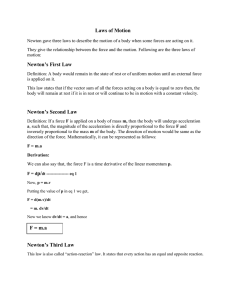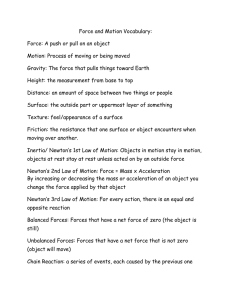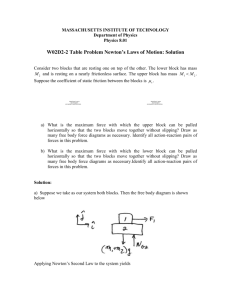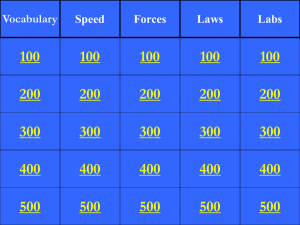W02D2-2 Table Problem Newton`s Laws of Motion: Solution
advertisement
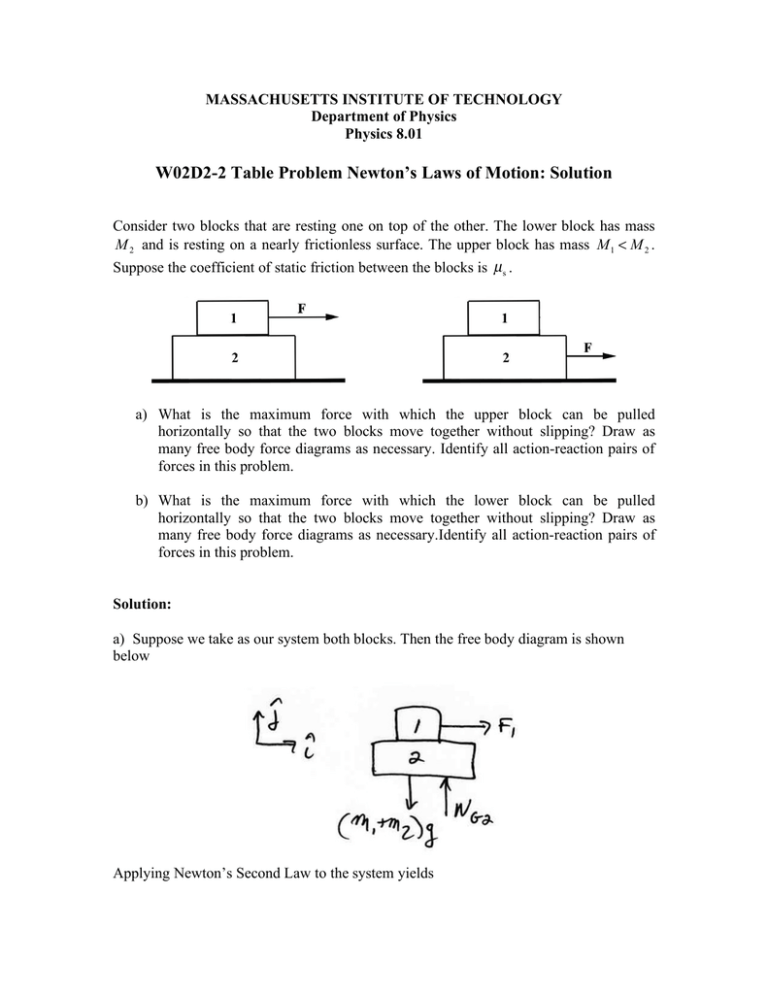
MASSACHUSETTS INSTITUTE OF TECHNOLOGY Department of Physics Physics 8.01 W02D2-2 Table Problem Newton’s Laws of Motion: Solution Consider two blocks that are resting one on top of the other. The lower block has mass M 2 and is resting on a nearly frictionless surface. The upper block has mass M 1 < M 2 . Suppose the coefficient of static friction between the blocks is µs . a) What is the maximum force with which the upper block can be pulled horizontally so that the two blocks move together without slipping? Draw as many free body force diagrams as necessary. Identify all action-reaction pairs of forces in this problem. b) What is the maximum force with which the lower block can be pulled horizontally so that the two blocks move together without slipping? Draw as many free body force diagrams as necessary.Identify all action-reaction pairs of forces in this problem. Solution: a) Suppose we take as our system both blocks. Then the free body diagram is shown below Applying Newton’s Second Law to the system yields î : F1 = ( M1 + M 2 )a ĵ : N G 2 ! ( M1 + M 2 ) g = 0 (1) Thus a = F1 / ( M1 + M 2 ) (2) However we have no knowledge of the internal forces between! the surfaces of block 1 and block 2, so we cannot determine whether or not the force F1 will cause them to slip relative to each other. ! In order to determine some condition F1 due to the fact that static friction cannot exceed some maximum value we must draw free-body force diagrams for the respective blocks as shown below. Note that the static friction force is the force that accelerates the lower block. The action-reaction pairs are: i. The gravitational force (magnitude M 1 g ) that the earth exerts on the upper block and the gravitational force (not shown) that the block exerts on the earth. ii. The gravitational force (magnitude M 2 g ) that the earth exerts on the lower block and the gravitational force (not shown) that the block exerts on the earth. iii. ! The normal contact force N 21 that the lower block 2 exerts on the upper block 1 ! and the normal contact force N12 that the upper block 1 exerts on the lower block 2. iv. ! The static friction force f21 , directed to the left in the figure, that the lower block ! 2 exerts on the upper block 1 and the static friction force f12 , directed to the right, that the upper block 1 exerts on the lower block 2. v. The upward contact force of magnitude N G 2 that the surface (ground, table, or other) exerts on the lower block and the downward contact force that the lower block exerts on the surface vi. Whatever or whomever is pushing the block will have a reaction force of magnitude F1 directed to the left. Applying Newton’s Second Law to the upper block yields î : F1 ! f 21 = M1 a1 ĵ : N 21 ! M1 g = 0 (3) where a1 is the acceleration of the upper block. Applying Newton’s Second Law to the lower block yields î : f12 = M 2 a2 ĵ : N G ! N12 ! M 2 g = 0 (4) where a2 is the acceleration of the lower block. The just-slipping conditions are that the accelerations are equal, a ! a1 = a2 , (5) and that the static friction has its maximum value, f 21 = ( f 21 )max = µs N 21 . (6) We can now solve the above equations for the acceleration of the blocks. The first equation in (3) implies N 21 = M1 g and so Equation (6) becomes (7) f 21 = µs M1 g . (8) Substituting Equations (8) and (5) into the first equation in (4), µs M 1 g = M 2 a (9) and the acceleration of the blocks is a1 = a2 = a = µs M 1 g M = µs g 1 . M2 M2 (10) The pushing force is then found by substituting Equation (10) into the first equation in (3) , F1 = µs M 1 g + M 1 ! M " µs M 1 g = µs M 1 g #1 + 1 $ . M2 % M2 & (11) Equivalently, we could have substituted our result for the acceleration from Eq. (2) into Eq. (10) resulting in a = µs g M1 = F1 / ( M1 + M 2 ) M2 (12) which yields the same result as Eq. (11) for the magnitude of the maximum possible pushing force on the upper block before the blocks slip. Check this result in the limits that one block is much heavier than the other. If M 1 ! M 2 , the lower block won’t move at all, and F1 ! µs M 1 g , the maximum static friction force. If M 1 ! M 2 , the lower block acts more or less as a lubricant, and the maximum force becomes very large. b) The free-body force diagrams are shown below when we push the lower block, The static friction force is now the only force that makes the upper block accelerate. The action-reaction pairs are the same as in part a) (except for (vi), the reaction force of magnitude F2 on whatever or whomever is doing the pushing). We again apply Newton’s Second Law to each block. Applying Newton’s Second Law to the upper block yields î : f 21 = M1 a1 ĵ : N 21 ! M1 g = 0. (13) Applying Newton’s Second Law to the lower block yields î : F2 ! f12 = M 2 a2 ĵ : N G ! N12 ! M 2 g = 0. (14) The just-slipping conditions are identical to Equations (5) and (6). Substitution of these into the first equation in (13) yield a = µs g (15) After substituting Eq. (15) and Equation (5) in the first equation in (14), we find that the maximum pushing force is F2 = µs M 1 g + M 2 µs g = µs g ( M 1 + M 2 ) . (16) Note that if we draw a free-body diagram on the compound system, the free-body force diagram looks like Newton’s Second Law in the horizontal direction then becomes ( ) î : F2 = M1 + M 2 a (17) which is easily solved for the acceleration a= F2 . M1 + M 2 (18) Then substituting Eq. (18) into Eq. (15) yields a= F2 = µs g M1 + M 2 (19) which we can solve for the maximum pushing force as given by Eq. (16). We note by comparing Equation (10) to Equation (15) that the acceleration of the blocks is greater when you push the lower block than when you push the upper block (recall that the problem statement specified M 1 < M 2 ). Recall that the static friction force is the only force accelerating the block that you are not pushing so when you push the lower block ( f s )max ! M1a ! M1 F2 (push lower book) . (20) When you push the upper block ( f s )max ! M 2 a ! M 2 F1 (push upper book) . (21) The maximum value of static friction between the blocks has the same magnitude in both cases. Therefore the product M 2 F1 = M1 F2 (22) F1 M = 1 F2 M2 (23) or So M1 / M 2 < 1 , then F1 / F2 < 1 and you can push the lower block with a greater force F2 > F1 .

